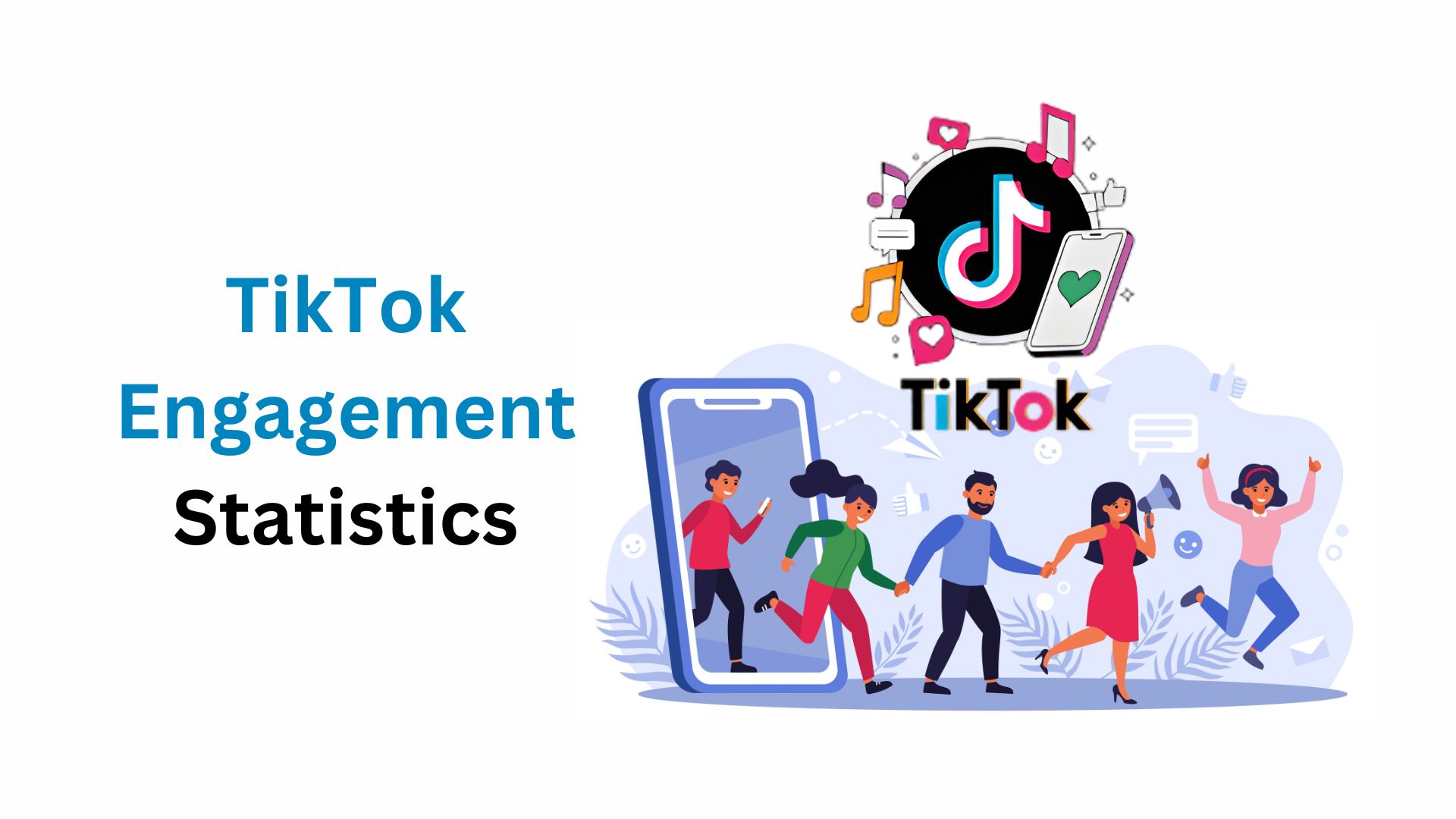Cyber Insurance Statistics and Fact By Market Size, Country, Top Players, Adoption Rates, Data Breach, and Trends (2025)
Updated · Sep 24, 2025

Table of Contents
- Introduction
- Editor’s Choice
- General Statistics
- Cyber Insurance Market Trends
- Top Players In Cyber Insurance Market Global
- Cyber Insurance Direct Written Premium
- Insurance Policies
- Cyber Insurance Adoption Rates
- Cyber Insurance Adoption By Country
- Familiarity And Experience With Cyber Insurance
- Insurance Policy Change In Premium
- Data Breach Statistics
- The Current Cyber Risk Landscape – Hot Spots
- Reasons For Insurance Claims Loss
- Conclusion
Introduction
Cyber Insurance Statistics: Cyber insurance had moved from being nice to have to really being a core risk tool by 2024. Why? The attacks kept rolling in, breach costs kept pushing upward, and boards wanted to have banks for purposes of financial protection as well as for help with incident response.
So, this article will provide straightforward cyber insurance statistics in 2024-market size, prices, losses, and claims.
Editor’s Choice
- The global cyberinsurance market expanded from US$2 billion in 2015 to a projected US$20.56 billion by 2025, with its fastest growth of 74.6% recorded in 2016.
- Chubb (16%), AIG (12%), and Beazley (10%) are the largest worldwide providers, while Tokio Marine (25%) dominates Asia.
- In the United States, direct written premiums totalled US$9.84 billion in 2023, an increase of 1.62% from 2022.
- The number of US cyber insurance policies rebounded to 4.3 million in 2022, an 11.7% increase over the previous year.
- Adoption rates: 76% of large US corporations and 47% of small businesses had active policies in 2023, while healthcare topped the list at 82%.
- A survey of mid-tier organizations showed that 90% had some sort of coverage, with Singapore leading with the highest adoption rates.
- While business leaders might feel confident in their understanding of coverage, 68% of respondents indicated they felt this way, only to trade 43% of IT wizards who found that the coverage was lacking after a breach.
- Hikes in premiums that were the highest during Q4 2021, with +34% came down during 2023, with 62% of clients seeing increases that were either flat or below 10%.
- In the first quarter of 2023, 6.41 million records were exposed globally; the average cost for a breach was US$4.45 million or US$165 per record.
- Companies equipped with security automation saved about US$1.88 million per breach in contrast to those lacking security automation.
- In 2023, record-high fines of US$1.19 billion were mercilessly sent down on Didi Global for a data privacy breach.
- Ransomware accounted for a 22% increase in the year 2023, with an average payoff by ransom of US$1.1 million per instance.
- About 25% of breaches were caused by cloud misconfigurations, while IoT devices received one or more billion attempts at attack on a global scale.
- The three top causes of claims continue to be ransomware-propagated claims (29%), business email compromises (15%), and credible hacker attacks (12%).
General Statistics
- Increasing dependence on digital data storage and communication has made cyber insurance more crucial for enterprises and individuals alike.
- The world cyber insurance market value in 2023 was approximately USUS$14 billion and is predicted to nearly double to USUS$30 billion by 2027, with most demand being corporate.
- Besides financial losses, these acts also tarnish the corporate reputation of companies, and are among the top-mentioned risks on a global level over the last few years.
- There is an ever-growing demand for cyber insurance because cybercrime is rising at an increased rate compared to insurance uptake.
- In the U.S., the number of data breaches has gone up over seven times since 2012, and the cost per data breach has grown about 70% in this period.
- Despite associated risks, in 2024, 87% of global workers were of the opinion that their companies were ill-prepared to counter cyberattacks.
- The rising cyber-attacks give more pie to insurance claims; this, in turn, threatens the profitability of the insurers.
- As claim payout exceeds gross premiums collected, the loss ratio increases; a sustainable loss ratio is usually between 60% and 70%.
- High claims caused the cyber insurance loss ratio to shoot above 160% in 2020 in France, but it has subsequently dropped back to 22% in 2022.
- In the US, the market stabilized as it witnessed growing premiums, with direct loss ratios declining to 43% by 2023, indicating an enhanced financial standing for insurers.
Cyber Insurance Market Trends
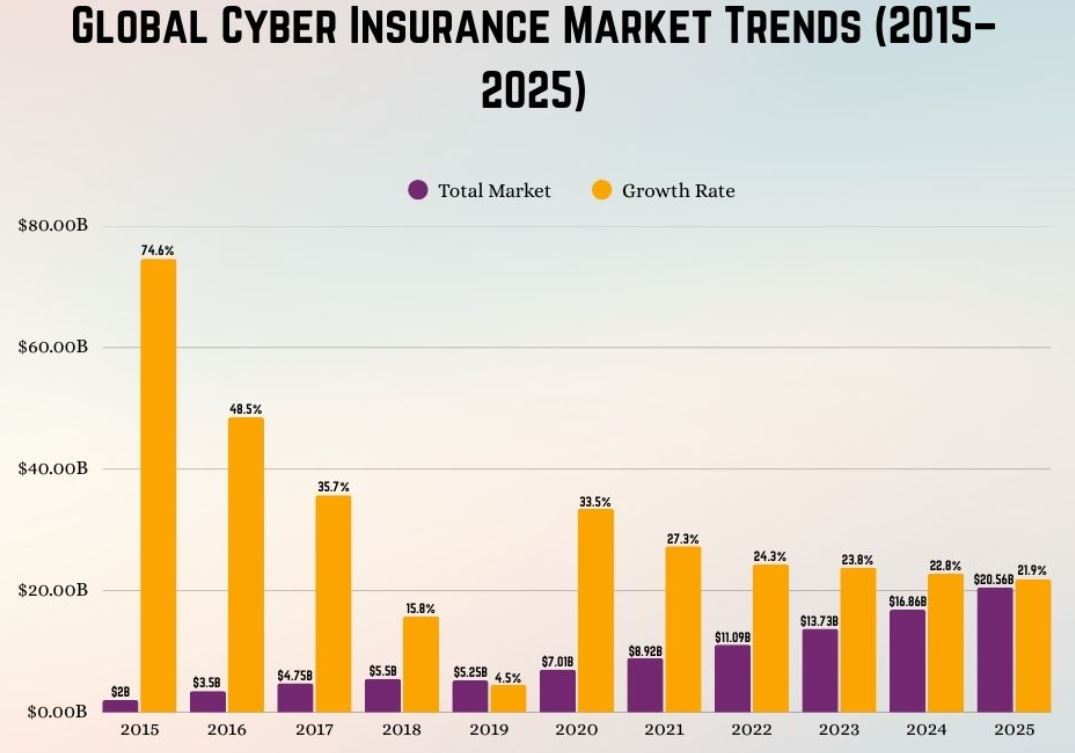
(Source: coinlaw.io)
- As per the Coinlaw report, cyber insurance statistics state that the global cyber insurance market has been growing at a rapid pace-from 2.0 billion in 2015 to US$20.56 billion by 2025.
- The most rapid expansion was in 2016, in which the market grew by 74.6% over its preceding year. During the period 2015-2017, the market was very vibrant, with values rising from US$2.0 billion to US$4.75 billion.
- The market then faced a rare downturn in 2019, shrinking by -4.5% to US$5.25 billion. However, it quickly bounced back in 2020 to US$7.01 billion, at a 33.5% growth rate.
- A steady pace of growth is envisaged post-2021 with forecasts pegging the market at US$8.92 billion in 2021 (+27.3%), US$11.09 billion in 2022 (+24.3%), US$13.73 billion in 2023 (+23.8%), US$16.86 billion in 2024 (+22.8%), and finally at US$20.56 billion in 2025 (+21.9%).
Top Players In Cyber Insurance Market Global
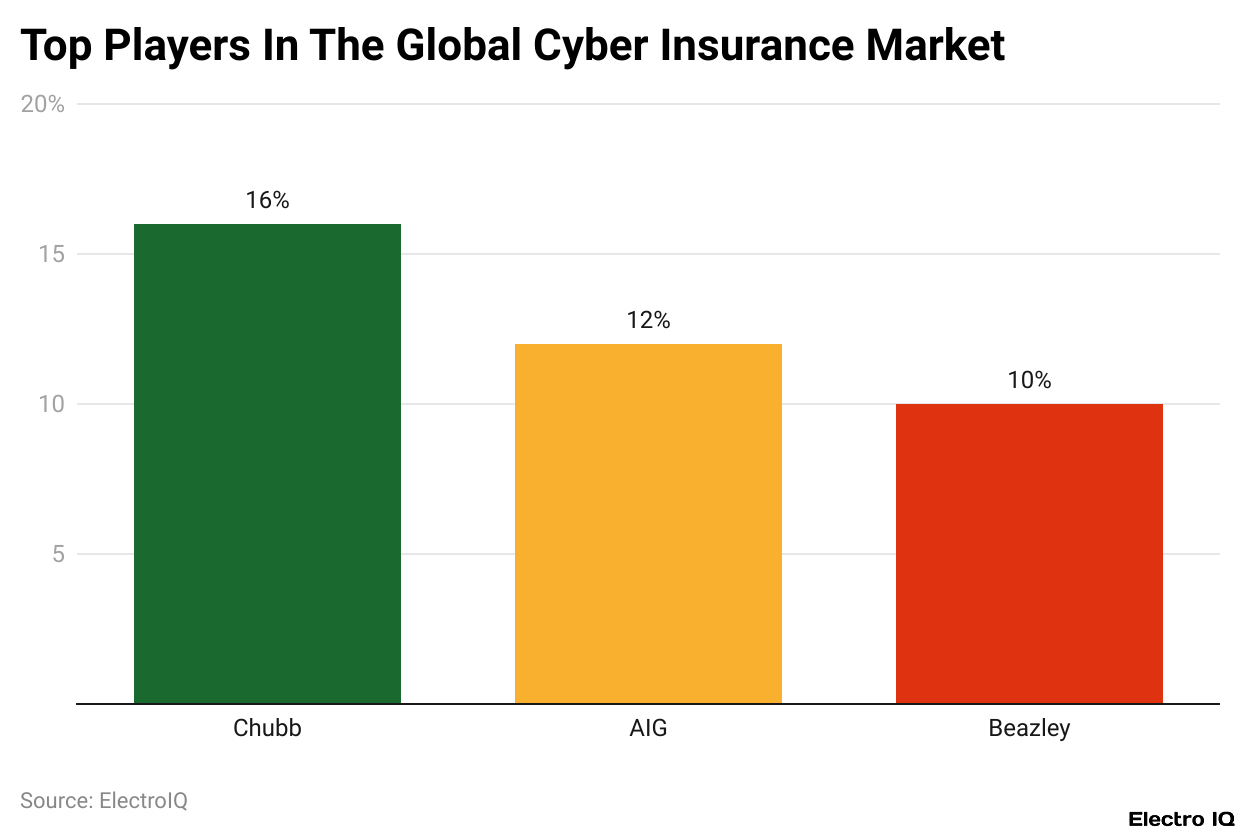
(Reference: coinlaw.io)
- Chubb is the largest actor in the cyber insurance market with a share of 16%, followed by AIG at 12% and Beazley at 10%.
- Local carriers dominated the patterns of providing in regional markets; for example, Tokio Marine holds 25% in the Asia region.
- It seems to show a high concentration in the U.S. market, where the top five carriers provide nearly 70% of cyber insurance.
- As of 2023, standalone cyber policies obtained more respect, forming 55% of the polices sold as opposed to 45% in 2022.
- Market penetration varies greatly among regions, with North America at 68%, whereas Africa stays way below 5%.
- Reinsurers have an elevated status, providing 20% of the underwriting in 2023 to support smaller carriers’ capacity.
Cyber Insurance Direct Written Premium
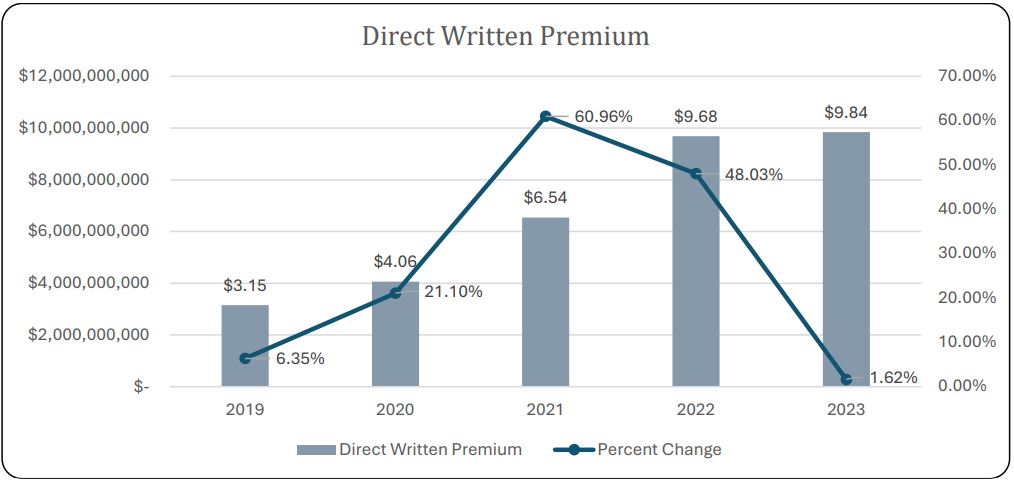
(Source: content.naic.org)
- These figures indicate that a mixture of U.S. domestic admitted insurers, surplus lines insurers, and foreign surplus lines insurers.
- Cyber insurance policies in the U.S. cyber insurance market saw their overall direct written premiums increase by 1.62% to US$9.84 billion in 2023, specifically for cyber coverage.
- This indicates a modest but steady growth in premium volume, showing demand for protection against cyber risks.
Insurance Policies
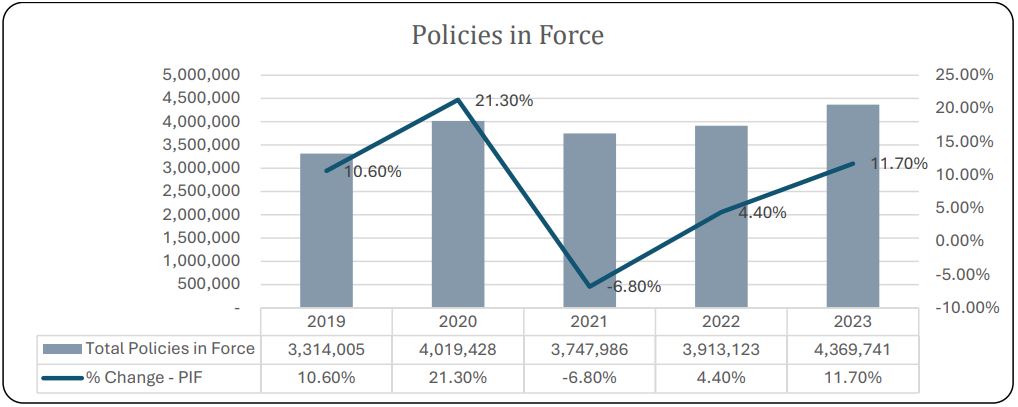
(Source: content.naic.org)
- The data demonstrates the trend in cyber insurance policies in force in the U.S. between 2019 and most of 2023, excluding those issued by alien surplus line intermediaries.
- After declining by 6.8% in 2021, the number of active policies still grew beyond 4.01 million that year.
- The market recovered somewhat the next year, when policies in force actually rose by 11.7%, from 3.9 million to 4.3 million.
- An increase of this nature showcases greater confidence and steadiness in the cyber insurance market, as more organizations have decided to pursue coverage amidst earlier turbulent periods.
Cyber Insurance Adoption Rates
| Sector/Region | Adoption Rate (%) |
Growth Rate (2023)
|
| Large corporations (US) | 76% |
Up from 62% (2022)
|
| Small businesses | 47% |
Growing awareness
|
| Healthcare | 82% |
Leading sector
|
| Education | 35% |
Online learning risks
|
| Regulated industries (US states) | >10 states |
Mandatory policies
|
| Europe (GDPR compliance) |
>50% for mid-sized enterprises
|
|
| Emerging markets (India, Brazil) |
20% growth year-over-year
|
(Source: coinlaw.io)
- In 2023, 76% of the large corporations in the US maintained active cyber insurance policies, a large increase from 62% in 2022.
- In many small and medium businesses, the experience of cyberattacks influenced adoption, with 30% having bought their first policy once they had been targeted by phishing.
- For those companies that already had insurance, in 2023, 70% were satisfied with how their insurer responded to incidents.
- Still, there remained 27% of policyholders who admitted that they had never quite understood their policy exclusions, of which the biggest concern was limited coverage for social engineering attacks, thus affecting 15% of claims.
- More positively, those companies that possessed better plans managed to recover from incidents 40% faster than those that had none.
Cyber Insurance Adoption By Country
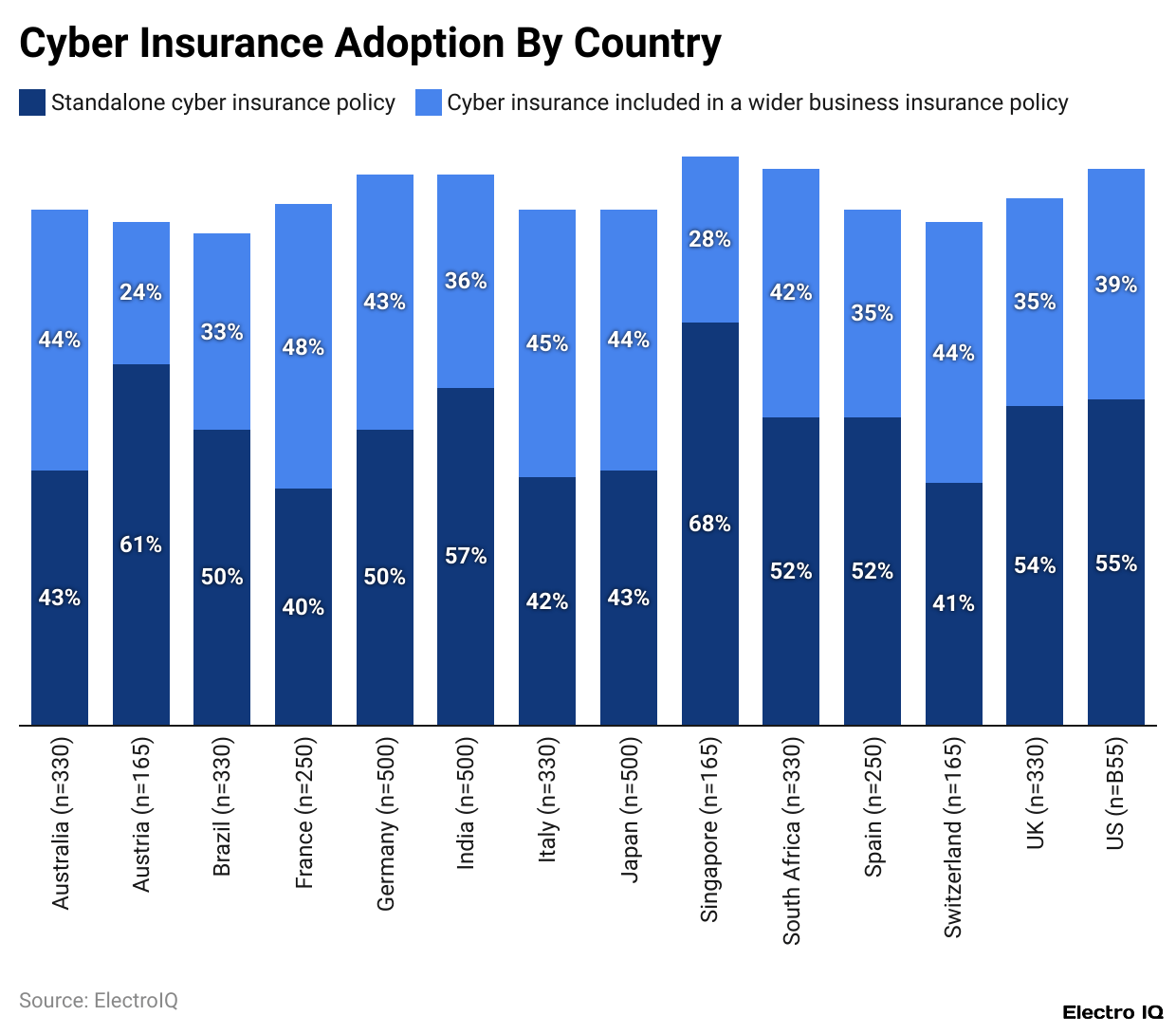
(Reference: news.sophos.com)
- The study of companies with 100-5,000 employees shows how common adoption is of cyber insurance, with 90% having some form of protection.
- About 50% have standalone cyber policies, while 40% have it covered as part of a business insurance policy package, such as general liability insurance.
- There were very high adoption rates throughout the 14 countries surveyed, with companies in Singapore arbitrarily defined as the country with the highest chance of having coverage.
Familiarity And Experience With Cyber Insurance
- There is a recent survey result stating that erudition in cyber insurance remains high at 68%, namely, directors who feel confident in their understanding of cyber insurance needed for their company.
- Yet almost forty-three percent of IT decision-makers found out their coverage was insufficient after they had gone through a breach.
- For many small and mid-sized businesses, experience with cyberattacks influenced adoption, with 30% buying their first policy after being targeted by phishing.
- Among companies that already had insurance, 70% were satisfied with how their provider responded to incidents in 2023.
- Still, 27% of policyholders admitted they did not fully understand their policy exclusions, with the most common concern being limited coverage for social engineering attacks, which affected 15% of claims.
- On a positive note, businesses with more comprehensive policies reported recovering from incidents 40% faster than those without coverage.
Insurance Policy Change In Premium
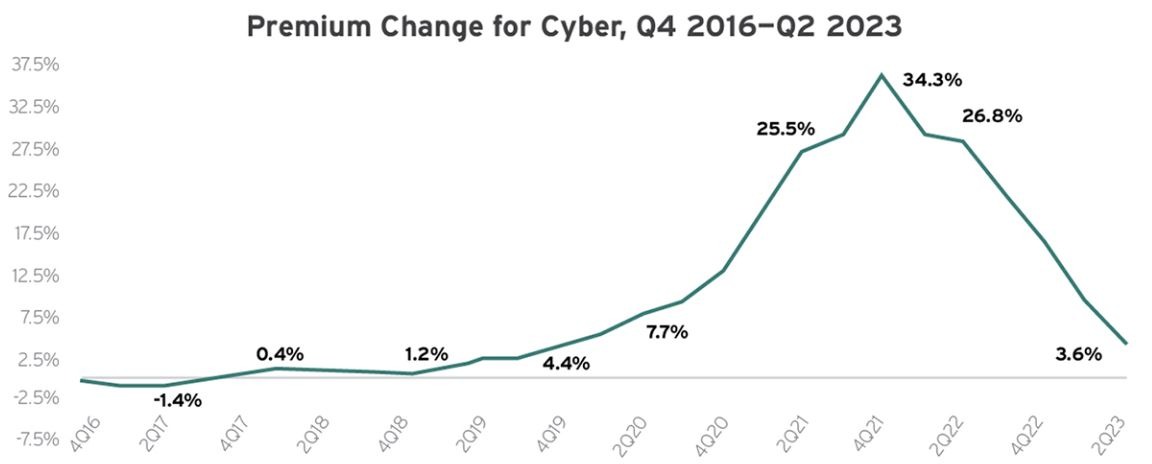
(Source: domrisk.com)
- From an industry perspective, by chit-chatting, one can say that the icing on the cake for cyber insurance premium hikes happens in late 2021 in the form of an average increase of 34% in Q4 and hovers in the double digits throughout 2022.
- Then, come 2022, underwriting profitability was restored, which provided some relief from market pressure.
- By 2023, the majority of policyholders were facing increases more manageable in the single digits.
- According to Zywave’s Hard Market Conditions Pulse Survey, 62% of brokers and agents stated that the premiums of their clients either went down, remained flat, or increased by less than 10% in 2023.
- Though there was a softer pricing environment, coverage restrictions, strict underwriting focusing on cybersecurity practices, and exclusions of certain risk scenarios such as wrongful data collection, cyberwar, and ransomware remained of concern to insureds.
- Companies with greater cyber exposures still faced double-digit rate hikes regardless of the system.
- Observing the trends into 2024, authorities predict that the market will continue to soften but at a slower rate compared to 2023.
- Being a line of insurers that reacts quickly to newly emerged risks, pricing swiftly becomes ungovernable.
- Those policyholders best positioned will be those with strong cybersecurity defenses and a contemporary understanding of the threats.
- Having premium increases and with tightened policy terms may lie the alternative for entities failing to maintain appropriate controls or increasing in losses.
Data Breach Statistics
- The first quarter of 2023 recorded some 6.41 million records globally exposed to data breaches, affecting millions across the world.
- On average, the losses incurred per compromised record were US$165, while the average overall cost of a data breach globally hit US$4.45 million.
- The data security market itself is moving swiftly, projected to hit US$6.86 billion in 2024 and further expand to US$11.19 billion by 2028.
- Security automation companies suffer less cost, averaging US$3.84 million per breach without automation, versus US$5.72 million with automation.
- The largest fine for a data breach ever was handed down in 2023: 1.19 billion against Didi Global Company.
- The trend of data breaches in healthcare is recording an upsurge in 2024 alone, with 491 breaches.
- Knowledge of data privacy regulations ranges from country to country, with India ranking at 67%.
- Most data breaches occur in North America, causing massive financial losses along a blow to the image.
- The most common target in these attacks was customer personal identifiable information (PII), accounting for over 52% of breaches worldwide in 2023.
- Employee PII was disclosed in nearly 90% of breaches, whereas 76% of social engineering attacks precipitated the theft of credentials.
- The industries hit hardest by malicious breaches include finance and insurance, highlighting attractiveness from an attacker’s perspective.
- At the global level, nearly 68 records get compromised per second, and some 71% of breaches are financially motivated.
- By September 2023, some 43% of breach victims were reported as small businesses, indicating that cybercriminals often go after organizations with fewer means for self-defense.
The Current Cyber Risk Landscape – Hot Spots
- Ransomware continued to sit at the top of major threat lists in 2023, with attacks increasing by 22% and ransom payments averaging US$1.1 million per incident.
- Energized by targeted assault activity rising by 30%, the critical infrastructure sectors of energy and transportation revealed their vulnerability.
- An estimated 25% of breaches were due to cloud misconfiguration, underlining the continued difficulty of cloud security.
- The manufacturing industry was the main target, accounting for 18% of attacks, while IoT devices came under immense strain, with over 1 billion attempted breaches recorded all over the world.
- There was a 25% increase in attacks against the financial services industry, most of which used AI to get past defensive mechanisms.
- Most attacks originated from North America and Europe, with the pair comprising 70% of cyberattacks worldwide.
Reasons For Insurance Claims Loss
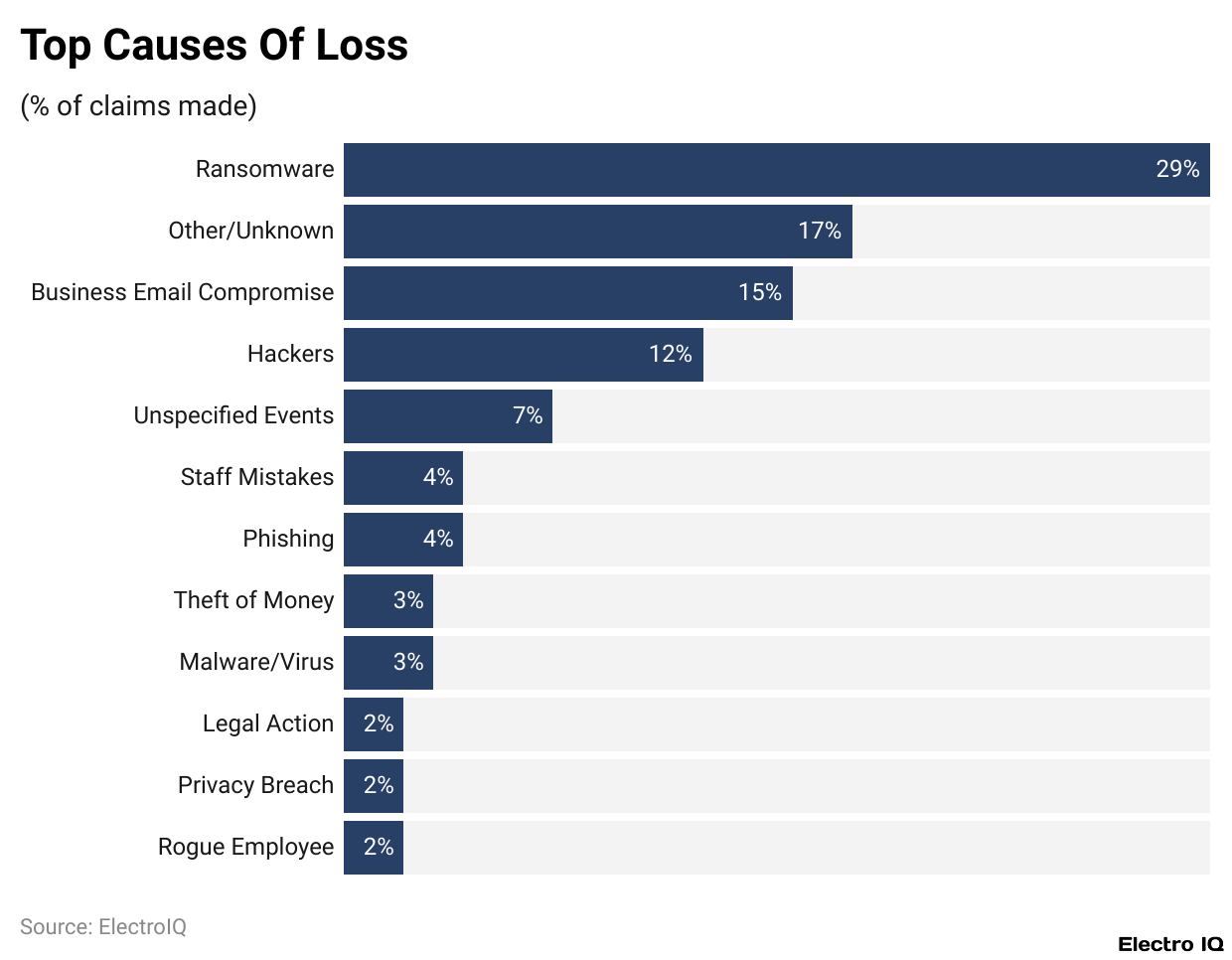
(Reference: networkassured.com)
- The data illustrates that ransomware is the biggest driver of cyber-insurance claims, accounting for 29% of losses reported.
- A rather large share from the other or unknown category, accounting for around 17%, is where the actual cause of loss is not clear.
- Business email compromise comes next, accounting for 15% of losses, after which direct hacker attacks account for 12% of claims.
- Unspecified events comprise 7% of claims, while staff errors and phishing account for 4% apiece.
- Financial losses related to the theft of money and malware-viruses are at 3% each.
- Legal actions (2%), privacy breaches (2%), and misdeeds by a rogue employee (2%) present less frequent, yet still important, causes of loss.
- This breakdown highlights the many different forms of threats, external and internal, that can unleash financial damages on an insured and trigger an insurance claim.
Conclusion
Cyber Insurance Statistics: In good measure propelled by growing cyber threats, costlier breaches, and growing demands from corporations to mitigate risk, cyber insurance saw a rapid evolution. While the market expanded from US$2 billion in 2015 to an anticipated US$20.56 billion by 2025, claims were led by the likes of ransomware, cloud misconfigurations, and email compromise.
Adoption by and large is widespread, especially so with large enterprises, whereas many policyholders remain unclear over exclusions. While 2019 saw the stabilization of cyber insurance premiums in contrast with previous years, the coverage is slowly being tightened. With breaches ever on the rise and cyber crimes evolving, cyber insurance is an essential tool in defense, albeit the future of the industry is dependent upon proper risk management and the COVID pandemic.
FAQ.
The worldwide cyber insurance market was worth around US$14 billion in 2023 and is expected to almost double by 2027, steadily growing at 20–25% per annum.
The top-ranking global providers are Chubb (16%), AIG (12%), and Beazley (10%). In Asia, Tokio Marine retains a 25% market share, while the US top five have about 70% market share.
An uptake of cyber insurance is highest in large US corporations (76%), followed by healthcare (82%) due to threats of ransomware. Education (+35%), finance, and energy are also fast in adoption. According to global reports, 90% of organizations with 100–5,000 employees consider themselves somewhat “covered” against cyber attacks.
Public premiums made their highest raises in the fourth quarter of 2021, increasing by 34%, and remained high throughout 2022. Most clients witnessed either flat or single-digit premiums growing in 2023. There were actually 62% of clients reporting their premium bases staying flat, dropping, or increasing less than 10%.
The main culprits are ransomware (29%), business email compromise (15%), and hacker attacks (12%). Contributors are errors from staff (4%), phishing (4%), theft of money (3%), malware (3%), rogue employees, and privacy breaches (2% each).

I hold an MBA in Finance and Marketing, bringing a unique blend of business acumen and creative communication skills. With experience as a content in crafting statistical and research-backed content across multiple domains, including education, technology, product reviews, and company website analytics, I specialize in producing engaging, informative, and SEO-optimized content tailored to diverse audiences. My work bridges technical accuracy with compelling storytelling, helping brands educate, inform, and connect with their target markets.

